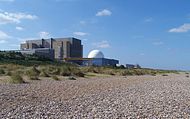- Nuclear Liabilities Fund
-
The Nuclear Liabilities Fund (formerly the Nuclear Generation Decommissioning Fund) is a fund of the UK Government to provide arrangements for funding certain long-term costs for the decommissioning of eight nuclear power stations formerly owned by British Energy. Responsibility for the Fund within government lies with the Shareholder Executive, on behalf of the Department of Energy and Climate Change.[1]
The Fund is owned by the Nuclear Trust, a public trust under Scottish Law. It consists of five trustees, three appointed by the Secretary of State for Energy and Climate Change and two by the owners of the nuclear power stations, now EDF Energy. The trustees are also directors of the Fund as well as owning the ordinary share capital of the Fund.[2]
Contents
History
The Nuclear Generation Decommissioning Fund was established on 28 March 1996 by the UK Government as part of the preparations for the privatisation of British Energy. It covered the nuclear power stations owned by the company on 20 March 1996, comprising seven advanced gas cooled reactor (AGR) stations and one pressurised water reactor (PWR) station. The obligations of the Fund were set out in an agreement known as the Nuclear Decommissioning Agreement. The Fund had an initial endowment of £232m and thereafter received £4m a quarter from British Energy, adjusted each year in line with RPI.[3]
On 14 January 2005, following the restructuring of British Energy after it required financial assistance from the government, the original agreement was terminated. It was replaced by the Contribution Agreement (CA) and the Nuclear Liabilities Funding Agreement (NLFA). Broadly, these agreements resulted in the following:[4]
- The renaming of the Fund as the Nuclear Liabilities Fund.
- Changes in decommissioning arrangements set out in the CA and the NLFA, such that the Fund continued to have the object of discharging the decommissioning liabilities of British Energy but also certain contracted and uncontracted nuclear liabilities. The Secretary of State agreed to fund these liabilities to the extent that they might exceed all the assets of the Fund.
- British Energy continued to pay quarterly contributions of £6m but in addition the Fund received £275m in 7% Guaranteed Bonds issued by British Energy, entitlement to 65% of British Energy’s free cashflow in each year and £150k per tonne in respect of fuel loaded at Sizewell B.
- The Trustees ceased to have responsibility for adequacy. The newly created Nuclear Decommissioning Authority (NDA) became responsible for determining liabilities. A first review of the Fund was to be carried out in January 2015 by the Fund and at each ten year anniversary thereafter or at any time after 2015 on the instigation of the Secretary of State.
Part of the Fund’s interest in British Energy was realised on 31 May 2007, when it converted approximately 30% of its entitlement to British Energy’s free cashflow into 450m British Energy shares. These were immediately sold to investors at a price of 520p per share, raising £2,340m.[5]
On 19 January 2009, the Fund sold its remaining 36% interest in British Energy following the takeover of the company by EDF Energy.[6] The sale raised a further £4,421m, taking the total Fund value at that date to £8,300m. This is to be invested to fund the long term decommissioning costs of EDF's eight former British Energy nuclear stations, plus certain other contracted and un-contracted nuclear liabilities relating to the assets as they arise.
See also
References
- ^ "DECC's Delivery Partners". Department of Energy and Climate Change. http://www.decc.gov.uk/en/content/cms/about/partners/partners.aspx.
- ^ "About the Fund". Nuclear Liabilities Fund. http://www.nlf.uk.net/index.html.
- ^ "Purpose". Nuclear Liabilities Fund. http://www.nlf.uk.net/history.html.
- ^ "History". Nuclear Liabilities Fund. http://www.nlf.uk.net/history.html.
- ^ "Government cuts stake in British Energy to fund decommissioning". The Independent. http://www.independent.co.uk/news/business/news/government-cuts-stake-in-british-energy-to-fund-decommissioning-451124.html.
- ^ "EDF completes takeover of British Energy". GreenWise. http://www.greenwisebusiness.co.uk/news/edf-completes-takeover-of-british-energy.aspx.
External links
- Nuclear Liabilities Fund website
- Planet Ark: UK nuclear liability fund gets go-ahead
- February 25, 2006, The Guardian: Bill to clean up nuclear sites rises by nearly £1bn
 Nuclear power in the United KingdomEnergy in the United Kingdom · Nuclear power
Nuclear power in the United KingdomEnergy in the United Kingdom · Nuclear powerCompanies and
organisationsBNFL (British Nuclear Fuels plc) · Civil Nuclear Constabulary · British Nuclear Group (BNG) · EDF Energy · Horizon Nuclear Power · Magnox Ltd · Nuclear Decommissioning Authority (NDA) · National Nuclear Laboratory · Nuclear Liabilities Fund · NuGeneration · Office for Nuclear Regulation · United Kingdom Atomic Energy Authority (UKAEA)
Reactors ActiveClosedBerkeley · Bradwell · Calder Hall · Chapelcross · Dungeness A · Hinkley Point A · Hunterston A · Sizewell A · TrawsfynyddSizewell B | DounreayNon-reactor sites Capenhurst (uranium enrichment) · Sellafield (reprocessing) · Springfields, Salwick (fuel manufacture) · Winfrith (research and development)Other Anti-nuclear movement in the United Kingdom · Franco-British Nuclear Forum · Nuclear power in Scotland · Tier 1 – UK Nuclear Site Management & Licensing
Categories:- Nuclear energy in the United Kingdom
- Department of Energy and Climate Change
- Nuclear liability
Wikimedia Foundation. 2010.
